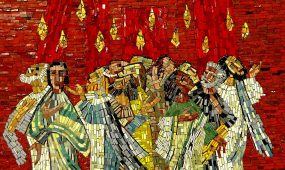Why did Jesus curse the fig tree?
Dates & Seasons
“The first image that comes into my mind whenever I think about the Lenten season is a deciduous tree – a tree that has no leaves on it that is preparing itself to regenerate new leaves, and with these, new life,” says The Rev’d Sam Sigamani from The Parish of Wynnum

The first image that comes into my mind whenever I think about the Lenten season is a deciduous tree – a tree that has no leaves on it that is preparing itself to regenerate new leaves, and with these, new life. Such a tree symbolises Lent as a time of preparation and renewal, although at this time of year in Queensland we are unlikely to witness a leafless deciduous tree.
Trees are commonly mentioned in the scriptures with profound theological themes, such as life, knowledge and wisdom, righteousness, protection and redemption.
The prophet Isaiah compares trees with the messianic coming (Isaiah 53). Jesus employs the use of plants and trees in his parables and other teachings. The four Gospel accounts variously refer to trees and other plants as metaphors about life, teachings and the suffering of Jesus.
Here, I would like to reflect upon the narrative popularly called ‘Jesus Curses the Fig Tree’. Different gospel accounts mention Jesus’ interaction with a fig tree from different perspectives. Matthew (21.18-22) and Mark (11.12-14, 20-25) narrate the so-called “cursing” of the fig tree in the context of Jesus’ entry into Jerusalem on a colt, thereby setting up the narrative of his crucifixion. Therefore, it is relevant for us to think about this passage during Lent.
I try to understand that Jesus’ engagement with the fig tree is a mutual interaction between him and the tree. The tree responded strongly to the words of Jesus by withering its leaves. We have examples from the Bible, and from the gospel accounts that nature and its living beings could listen, respond, co-operate, and participate in the work of God. The story of Balaam and the donkey (Numbers 22.21-35), Jonah and the fish (Jonah 1.17- 2.10) and Jesus calming the storm (Luke 8.22-25) are good examples of how nature participates in God’s work. Looking at the placement of the narrative in the gospel accounts, I think upon the following question: Can the tree’s withering be seen as a self-sacrificing act of solidarity with Jesus’ self-sacrificing act on the tree of the cross?
Advertisement
Jesus was soon to be nailed on the tree of the cross. Jesus’ act on the cross is a redemptive act of God. The salvation of Christ Jesus benefits the whole of creation, including humans. The fig tree, which was living on the (high)way to Jerusalem in my imagination, can be seen as symbolic of individual trees that once lived together as forests but have been deforested. So I am prompted to ask, “Are these trees not also redeemed?”
I have lived in a place where, in the names of urbanisation and development, deforestation has been carried out systematically. I have witnessed places that once had trees providing shade, food and a haven for many birds and other living creatures turned into highways and skyscrapers. Trees were replaced by concrete bridges, apartments and carparks. The land, trees and wider ecosystem were once a habitat of many creatures that are now endangered species. This has severely impacted the ecosystem and its eco-balance.
Advertisement
In a globalised world, ecological damage is both a specific context-based and a universal issue. What is carried out in the name of development in one part of the globe benefits other parts of the globe. This gives humans a shared responsibility towards preservation of nature and her gifts to us, and accountability for exploitation and abuse of natural resources, like forests.
It is easier, but less significant, to say that the fig tree was just used by Jesus to teach the disciples a lesson about faith and prayer. It is more meaningful to understand the withered fig tree within the narration of Jesus’ redemptive act because it reminds us to recognise Jesus’ redemptive act for both humans and the rest of the creation, thus calling us to responsible intervention as Christians to reverse ecological damage.
May this Lent be a time for us to experience God’s salvation together with the rest of God’s good creation.
Editor’s note: Download the 2023 Doing Justice Lent Reflections, written by The Rev’d Deb Bird from The Parish of Maleny, Montville and Kenilworth and The Parish of Palmwoods, and designed by the Justice Unit’s, Peter Branjerdporn, for your smartphone now. The reflections are also available as shareable images and printable posters online.





